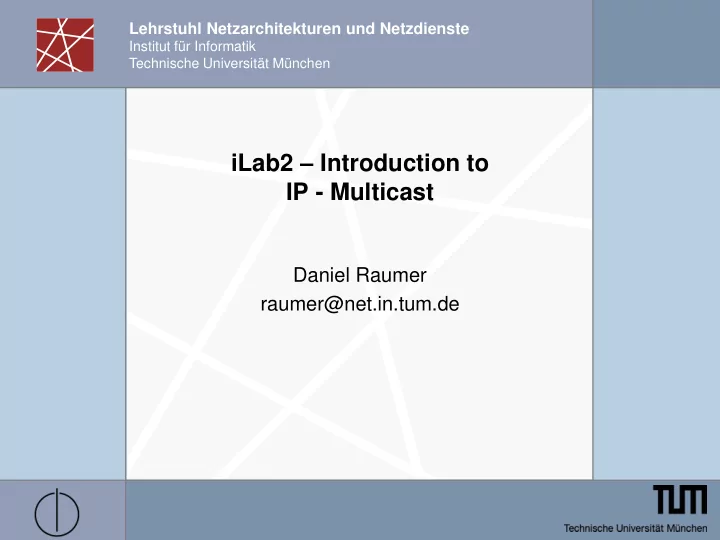

Lehrstuhl Netzarchitekturen und Netzdienste Institut für Informatik Technische Universität München iLab2 – Introduction to IP - Multicast Daniel Raumer raumer@net.in.tum.de
“What is he talking about?” Multicast? Motivation Layer-3 (IP) Multicast Wrap-Up iLab2 – Introduction to IP-Multicast – Daniel Raumer – 2013-11-14 2
Multicast Concept Unicast Broadcast Multicast Anycast? Geocast? Multicast on layer n can be realized by unicast connections on layer n-1 On which layer? Physical layer on a shared medium IP Layer to avoid traffic Application layer e.g. to simplify communication in online games iLab2 – Introduction to IP-Multicast – Daniel Raumer – 2013-11-14 3
Multicast – Why? iLab2 – Introduction to IP-Multicast – Daniel Raumer – 2013-11-14 4
Multicast – Why? iLab2 – Introduction to IP-Multicast – Daniel Raumer – 2013-11-14 5
Multicast – Who? iLab2 – Introduction to IP-Multicast – Daniel Raumer – 2013-11-14 6
Multicast – Who? During champions league final in 2012 no live TV broadcast in Italy Traffic at TOPIX (an Italian IXP) iLab2 – Introduction to IP-Multicast – Daniel Raumer – 2013-11-14 7
Multicast – Who? Football Worldcup 2010 Video streams with1.5 MBit/s per User - and this is not hd ;-) Continuously for up to 2 hours 180 000 concurrent streams in Germany 270 000 MBit/s or about 270 GBit/s Provider Networks 200 User 300 MBit/s 300 MBit/s 1000 User 2550 MBit/s 1500 MBit/s 2250 MBit/s 2550 MBit/s 750 MBit/s 500 User iLab2 – Introduction to IP-Multicast – Daniel Raumer – 2013-11-14 8
2011 Example iLab2 – Introduction to IP-Multicast – Daniel Raumer – 2013-11-14 9
2011 Example iLab2 – Introduction to IP-Multicast – Daniel Raumer – 2013-11-14 10
2011 Example iLab2 – Introduction to IP-Multicast – Daniel Raumer – 2013-11-14 11
2011 Example iLab2 – Introduction to IP-Multicast – Daniel Raumer – 2013-11-14 12
2011 Example Vodafone Network: + 20,5 % Data Traffic iLab2 – Introduction to IP-Multicast – Daniel Raumer – 2013-11-14 13
2011 Example Vodafone Network: + 20,5 % Data Traffic Youtube Lifestream: 400 000 000 Viewers iLab2 – Introduction to IP-Multicast – Daniel Raumer – 2013-11-14 14
2011 Example Vodafone Network: + 20,5 % Data Traffic Youtube Lifestream: 400 000 000 Viewers Obama Inauguration 70 000 000 Viewers iLab2 – Introduction to IP-Multicast – Daniel Raumer – 2013-11-14 15
2011 Example Vodafone Network: + 20,5 % Data Traffic Youtube Lifestream: 400 000 000 Viewers Obama Inauguration 70 000 000 Viewers Akamai: 1 600 000 concurrent streans iLab2 – Introduction to IP-Multicast – Daniel Raumer – 2013-11-14 16
2011 Example Vodafone Network: + 20,5 % Data Traffic Youtube Lifestream: 400 000 000 Viewers Obama Inauguration 70 000 000 Viewers Akamai: 1 600 000 concurrent streans iLab2 – Introduction to IP-Multicast – Daniel Raumer – 2013-11-14 17
Multicast – And how does it work? Back in the old days of the Internet 1985 (2 years after switch day) -RFC 966 - A Multicast Extension to the Internet Protocol • Paper Cheriton et al: “The extensive use of local networks is beginning to drive requirements for internet facilities…” 1986 National Science Foundation: Largest Backbone: 56 kbit/s 1989 - RFC 1112 - Host Extensions for IP Multicasting 200 User 1.5 MBit/s 1.5 MBit/s 1000 User 1.5 MBit/s 1.5 MBit/s 1.5 MBit/s 1.5 MBit/s 1.5 MBit/s 500 User Other application scenarios? iLab2 – Introduction to IP-Multicast – Daniel Raumer – 2013-11-14 18
Multicast – Addressing All Class D addresses are multicast addresses 1 1 1 0 multicast group id Class D 28 bits Class From To D 224.0.0.0 239.255.255.255 Address space is managed by IANA Divided into different blocks with certain purposes Examples: 224.0.0.1 addresses all hosts on the same network segment. 224.0.0.2 addresses all routers on the same network segment. The Cisco multicast router AUTO-RP-ANNOUNCE address is used by RP 224.0.1.39 mapping agents to listen for candidate announcements. iLab2 – Introduction to IP-Multicast – Daniel Raumer – 2013-11-14 19
Multicast – joining and leaving a multicast group Internet Group Management Protocol (IGMP) IGMPv1 (RFC 1112) IGMPv2 (RFC 2236) “Join” to the DR “Prune” to the DR IGMPv3 (RFC 3376, RFC 4604) 0 MBit/s 0 Users 1.5 MBit/s 200 User 0 MBit/s 1.5 MBit/s 1.5 MBit/s 1.5 MBit/s 1000 User 1.5 MBit/s 1.5 MBit/s 1.5 MBit/s 500 User 1.5 MBit/s 300 User Same but different for IPv6 Multicast Listener Discovery (MLD) MLD is part of ICMPv6 instead of using a separate protocol. MLDv1 ~ IGMPv2, MLDv2 ~ IGMPv3 (RFC 3810, RFC 4604) iLab2 – Introduction to IP-Multicast – Daniel Raumer – 2013-11-14 20
Multicast – different modes Protocol Independent Multicast } Known from the Prelab Sparse Mode (SM) Dense Mode (DM) Bidirectional PIM (Bi-Dir) Source-Specific Multicast (SSM) PIM-DM messages Type PIM-DM PIM-SM } Hello 0 to determine the DR Register 1 Register-Stop 2 for group management Join/Prune 3 Bootstrap 4 Assert 5 Graft 6 Graft-Ack 7 Candidate-RP- 8 Advertisement iLab2 – Introduction to IP-Multicast – Daniel Raumer – 2013-11-14 21
Multicast – different modes Source Trees One source of traffic GroupID and SourceID required for joining the group Shared Trees Different sources of traffic Distribution tree is shared among all senders Only GroupID is required to join a group RP? Rendezvous Point (RP) RP can be configured statically …or via mechanisms like Auto -RP or Bootstrap Router (BSR) iLab2 – Introduction to IP-Multicast – Daniel Raumer – 2013-11-14 22
Wrap-Up IP- Multicast used mainly in enterprise IP-networks Why? delays complexity to the routers Many Protocols, mechanisms & related buzzwords ;-) PIM -DM PIM-SM IGMPv3 PIM-SSM ICMP & MLD IGMPv1 IGMP v2 … and many others & all belonging RFC‘s One last question: “Why is PIM called ‘protocol independent’ ?” … at least It‘s a small lab - I wish you fun doing it iLab2 – Introduction to IP-Multicast – Daniel Raumer – 2013-11-14 23
The End iLab2 – Introduction to IP-Multicast – Daniel Raumer – 2013-11-14 24
Recommend
More recommend